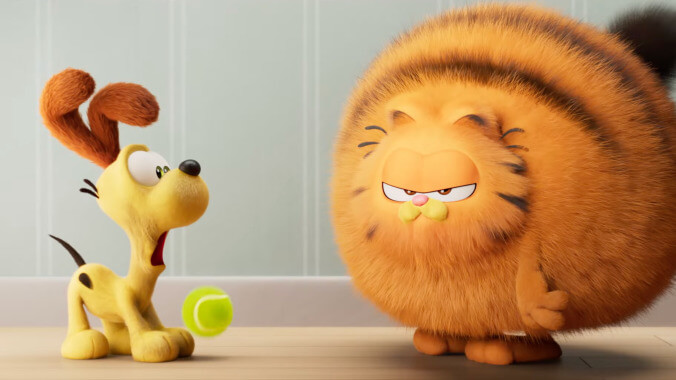The Garfield Movie review: Identity-free adaptation is Garfield minus Garfield
This orange tabby bears little resemblance to the comic strips, but your youngest child isn’t likely to care

In this increasingly cynical age of recycled intellectual property, it’s probably not surprising that we would get a new cinematic adaptation of Garfield, especially given the original comic’s perpetual status as meme fodder for every online generation to rediscover. However, what’s most surprising about The Garfield Movie is how young an audience this cinematic adventure is aiming for, completely bypassing viral culture in favor of kids without the reading comprehension to appreciate Jim Davis’ slice-of-life strips. That’s a creative choice that begs the hackneyed question of who this movie is even for, since fans of Garfield won’t find much here to wax nostalgic for, and the kids who like this movie will find closer comparisons in any number of other generic animated films from the last two decades.
Voiced by Chris Pratt, the actor you hire when you desperately want your character to sound exactly like Chris Pratt, this incarnation of the orange tabby cat starts the film by narrating directly to the audience about his origins, abandoned by his stray father before finding his way into the arms of the manipulable Jon Arbuckle (Nicholas Hoult). Now a grown cat with his mute sidekick Odie the dog – vocalized by Harvey Guillén and characterized less as a naïve doofus than as a begrudging intern – Garfield finds himself abducted by the cat Jinx (Hannah Waddingham) in a bid to draw his father Vic (Samuel L. Jackson) out of hiding. To escape her wrath, Garfield, Odie, and Vic must learn to work together to steal a shipment of milk in a heist on a corporate farming operation.
Aside from an opening montage showcasing how Garfield always gets his lazy, food-grubbing way, there’s not much to distinguish the character by more than his marketable design, while the story mostly adheres to the obvious motions: establishing the divide between Garfield and Vic before having them inevitably reconcile as father and son. That’s not a bad template to follow, given that the target demographic will have barely started school, but The Garfield Movie never has the confidence needed to convey its narrative with a consistent tone. At its best, the action is sub-Looney Tunes slapstick: nothing to write home about, but sufficiently amusing if you don’t want your cartoon characters to look like they’re getting hurt too badly. But then the pacing will grind to a halt as soft, melancholic piano music underpins moments of emotional growth, an apparent bid to appeal to parents’ sense of maturity that unnecessarily drags out the experience. Faced with the choice of boring either kids or their parents, The Garfield Movie can’t even fully commit to being a key-jangling distraction.
It certainly doesn’t help that The Garfield Movie has, appropriately enough, an extremely lazy sense of humor. Director Mark Dindal (The Emperor’s New Groove, Chicken Little) fails to pace the visual gags with the appropriate amount of punch, letting theoretically funny visuals, like a failed lasagna cooking experiment, linger without framing them to provoke a laugh. Garfield’s fourth-wall-breaking quips are generally one step removed from boilerplate observations found in any hack screenplay, and there’s a bizarre fixation on Tom Cruise pastiches, directly referencing both Mission: Impossible and Top Gun in extended sequences that feel like product placement for adults. Ving Rhames is even cast as a heist-coordinating bull version of Luther Stickell, just to really hammer the non-joke home.
In fact, the farther Garfield’s journey deviates from the comforts of Jon Arbuckle’s home, the less it feels like it has any identity at all. The milk heist, complete with Rube Goldberg factory machinations, reads like a reworked Chicken Run spin-off, complete with human character designs that look less like Jim Davis creations than Aardman rejects. Rhames’ character and his kidnapped love interest feel like undeveloped creations of turn-of-the-millennium Disney. Jon’s entire B-plot is spent literally waiting on hold, while Nermal makes a brief, voiceless cameo. These aren’t the grumblings of a Garfield superfan, just the confused musings of someone hoping for any sort of creative vision to shine through.
But creative vision isn’t really the point here, is it? Garfield is just a marketable character, so who cares about finding a way to adapt the Sunday comic strip’s sense of humor into something that works on-screen? As long as there’s another excuse to slap Garfield’s smiling mug on another t-shirt, then by all means, let’s keep the train rolling with a new generation of fans. Yet, when brand perpetuation is as soulless and milquetoast as this, it seems unlikely that it will create any new fans at all.